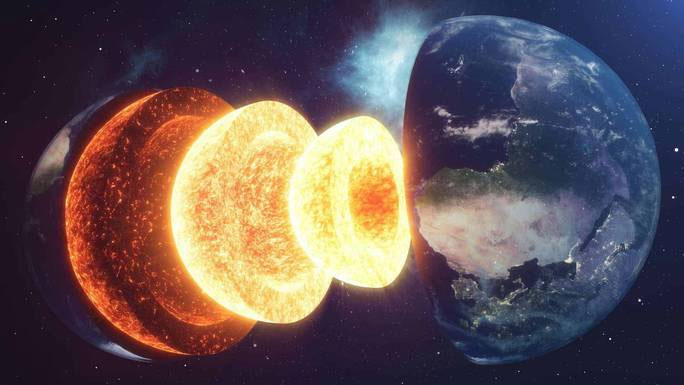A mysterious phenomenon in the Earth’s outer core has shifted from its previous position in just 20 years, possibly related to the North Pole of the Earth drifting from Canada towards Siberia, Russia.
The study, led by geologist Ying Zhou from Virginia Polytechnic Institute and State University, examined geological waves generated by two earthquakes that occurred in similar locations but 21 years apart.
These earthquakes took place near the Kermadec Islands in the South Pacific, the first in May 1997 and the second in September 2018.

Structure of the Earth’s interior – (Image: SCITECH DAILY)
The results revealed significant changes in the Earth’s outer core, a layer made up of liquid iron and nickel, located between the mantle (the layer of rock beneath the crust) and the inner core of the Earth. The outer core directly influences the planet’s magnetic field, acting as a protective shield against harmful cosmic elements.
“Something has changed in the path of that wave, so now it may be traveling faster,” Dr. Zhou told Science Alert.
The material along the seismic wave’s path is new and lighter, potentially containing elements such as hydrogen, carbon, and oxygen that have been released in the outer core since 1997.
This change in material suggests there has been a disturbance in the core, causing materials from different locations to move to new areas.
The research team believes this is directly connected to the phenomenon of the Earth’s North Pole – the true magnetic North Pole – which is no longer located at what is referred to as the “Arctic” on maps but is drifting in the Arctic Ocean, nearing the shores of Siberia, Russia.
The movement of the North Pole is thought to be a precursor to the phenomenon of “geomagnetic reversal,” where the South Pole would shift to the current position of the North Pole while the actual North Pole “drifts” down to the center of the Antarctic continent.
Geomagnetic reversal does not lead to apocalyptic scenarios, but it could damage human radio and telecommunications systems and thrust us into a phase of weakened magnetic fields and harsher climates due to increased exposure to intense solar radiation.
Dr. Zhou’s research team plans to continue monitoring changes in the Earth’s outer core using a network of 152 global seismic stations to gain a better understanding of this deep and mysterious world.
The preliminary research was recently published in Nature Communications Earth & Environment.


















































